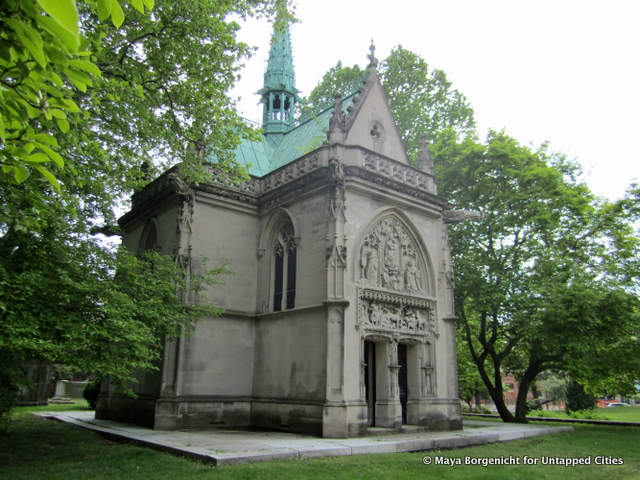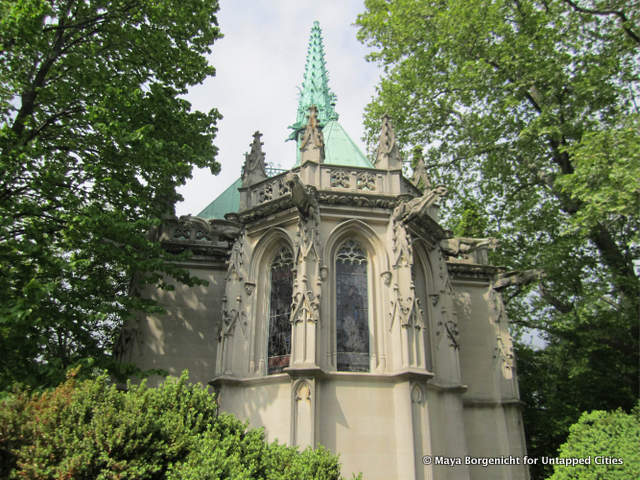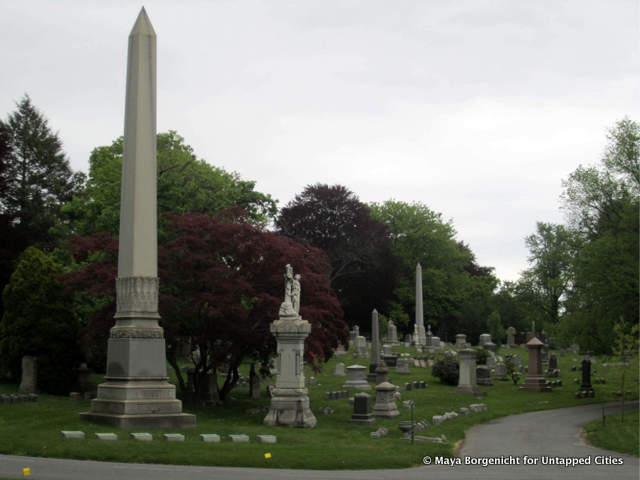Woodlawn Cemetery is nearly half the size of Central Park, and has the population of a small city – of dead people. Located at the northern terminus of the #4 line, it offers miles of twisting, tree lined paths that wind over hills and through meadows, passing architecture by the likes of McKim Mead & White, Cass Gilbert and Carrère and Hastings. These architectural monuments are the centerpieces of the landscape. One of the most magnificent in the cemetery is the Belmont Mausoleum, the final resting place of Alva Erskine and Oliver Hazard Perry Belmont.
Opened in 1863, Woodlawn Cemetery is comprised of over 400 acres of rolling hills, circular paths and mausoleums meant to evoke miniature gothic cathedrals, Grecian temples and Egyptian tombs (one was once complete with reeds, water and sand – it was later removed). Woodlawn was born of the “rural cemetery” movement. In the mid 19th century reformers decided that the city had reached a population and density that made cemeteries within Manhattan a public safety hazard. In 1847 the New York Legislature passed the Rural Cemetery Act paving the way for dozens of cemeteries to be built outside the city, in what would later become New York’s outer boroughs. Diverging from the churchyard style cemeteries that preceded them, these new rural cemeteries were rolling manicured landscapes designed to be an attractive place for prominent citizens to build their last resting places.
New York’s wealthiest citizens built these mausoleums with style and grandeur that matched the 5th Avenue mansions they spent their living years in. Now, nearly a century later, these magnificent monuments are in need of restoration. Some of the cemetery’s residents set up trusts before their death to care for the mausoleums in perpetuity. Others, it would seem, simply assumed that their friends and family (even if they had no children) would continue to care for their final resting place. However, many have been left without funds to pay for basic maintenance such as leaking roofs or masonry deterioration. Belmont Mausoleum is one of monuments at Woodlawn that do not have caretakers.
The Belmont Mausoleum was built in 1908 by Alva Belmont, born Alva Erskine Smith in Mobile, Alabama in 1853. Alva’s first marriage was to Williams Kissam Vanderbilt who she, in a shocking move for the period, divorced and then shortly thereafter remarried Oliver Belmont. The Belmont mausoleum was built by the architecture firm Hunt & Hunt, architects Alva had commissioned to build a number of her grand houses. Alva’s controversial and fascinating life (which included fighting vehemently for women’s suffrage) is well documented in the entertaining, Fortune’s Children by Arthur T. Vanderbilt, one of the descendants of the Vanderbilt family.
It was ornate mausoleums like the Belmont’s that drew enormous crowds in the late 19th and early 20th centuries. Cemeteries like Woodlawn were popular destinations for casual recreation; visitors came for family outings, carriage rides or architectural walks. Since then visitor-ship has fallen sharply – people no longer visit these cemeteries in the same numbers they once did.
Few people think to head to a cemetery for a springtime day trip, and drawing visitors back to these cemeteries is a challenge. You can’t extol their great diversity of programs or their endless potential for new uses; cemeteries are traditionally thought of as gloomy, somber places. But these cemeteries are much more than that – each measuring hundreds of acres, they represent a huge amount of open space right in New York City. Their works of art and architecture deserve to be seen by today’s visitor and the cemeteries as a whole have much to offer to the 21st century urbanite. To get to Woodlawn you take the #4 line to its end, emerging in the northern reaches of the Bronx passing historic gate houses that usher you into the landscaped lawns of the cemetery. A tour on the day I visited took us past many of the most spectacular monuments, but on your own it would be easy to get lost wandering through the circular paths, finding yourself in front of enormous weeping beach trees or spectacular stained glass windows.
A grant from Partners in Preservation would pay for the Mausoleum to clean the outside and return the cross that has fallen off to the top of the building. Not only would the renovation of the Belmont Mausoleum save a beautiful monument, it would be a step in a larger process to restore the hundreds of monuments in Woodlawn Cemetery and revive the cemetery as a destination for visitors to appreciate the spectacular art, sculpture and architecture that abounds there.
Click here to vote for the Belmont Mausoleum at Woodlawn Cemetery. Follow Untapped Cities on Twitter and Facebook. Get in touch with the author @mayaborgenicht.
Untapped Cities is an official blog ambassador for Partners in Preservation , a community-based initiative by American Express and the National Trust for Historic Preservation to raise awareness of the importance of historic places. Stay up-to-date with Untapped’s coverage of all 40 sites by following our Partners in Preservation category.









